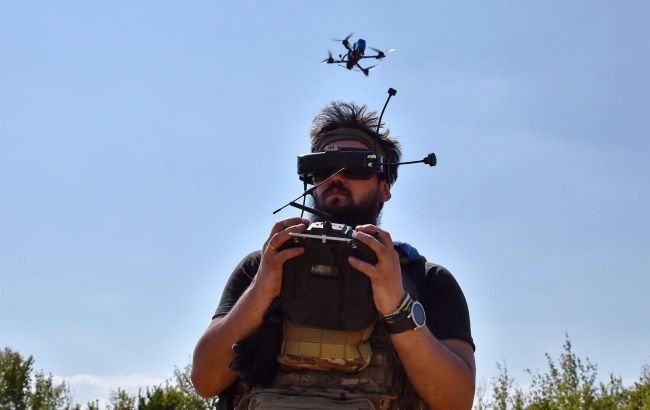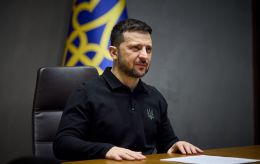Ukraine's experiment: Can civilian volunteers shoot down Russian Shahed drones?
 Ministry of Defense wants to create squads to counter Shahed drones (Photo: Getty Images)
Ministry of Defense wants to create squads to counter Shahed drones (Photo: Getty Images)
The Cabinet recently launched an experimental program to recruit volunteers for drone defense operations. The initiative aims to strengthen countermeasures against Iranian-made Shahed drones that Russia launches nightly against Ukrainian targets.
What we know about this program and whether the Defense Ministry's experiment will prove effective, in this article by RBC-Ukraine.
Key questions
- What is known about the experimental project?
- Will anti-aircraft drones help counter the Shahed drones?
- What are the difficulties with the Ministry of Defense's idea?
- Is civilian aviation effective against Shahed drones?
With almost every large-scale attack, Russia launches more and more drones against Ukraine. On the night of May 25, Ukrainians were attacked by 250 Shahed drones and decoy drones. During the attack on the night of June 1, there were 472 strike drones and decoys, and on the night of June 9 – 479. The Russian trend is toward escalation.
At the same time, the Russian forces have changed their attack tactics. The enemy selects a populated area or target and launches massive attacks with large numbers of drones. They use decoy drones to overload Ukrainian air defenses and launch drones at high altitudes where, although visible to radar, they remain out of range of mobile fire teams' machine guns. As a result, some Shahed drones still manage to reach their targets.
The government recently approved a resolution to launch an experimental project to strengthen countermeasures against strike drones. The project, initiated by the Ministry of Defense, involves creating air defense groups from among members of territorial community volunteer formations (TCVF).
What the Ministry of Defense is proposing
The air defense groups, according to the Ministry of Defense, will report to Territorial Defense Force commanders and the Air Force command, and will be organized on a territorial basis.
The groups will include volunteers who are not subject to mobilization and have completed appropriate training. These volunteers will be able to use strike drones, piloted aircraft, personal firearms, electronic warfare systems, and artificial intelligence systems to defend the skies.

Photo: Russians attack Ukrainian cities and villages with Shahed drones daily (Getty Images)
How effective are anti-aircraft drones against Shahed drones
According to the Main Intelligence Directorate, Russians produce approximately 2,700 Shahed drones and nearly the same number of decoy drones each month. To counter long-range enemy drones, mobile fire teams began forming across regions in early 2023. These consist of fighters in off-road vehicles equipped with machine guns or automatic cannons.
Today, according to military expert Pavlo Narozhnyy, mobile groups shoot down the largest number of Shahed drones. Other means are also used to counter strike drones – EW systems, MANPADS, SAM systems, aircraft, and helicopters. As well as anti-aircraft drones.
"This is a new direction with both pros and cons. What are the pros? The cost of one such drone is $1,000. The cons: each anti-aircraft drone needs an operator. This has to be a person who guides it to the target," the expert told RBC-Ukraine.
In other words, if 200, 300, or 500 drones are heading toward Kyiv or another city, you'll need just as many anti-aircraft drones, Narozhny clarified. And the larger the area that needs protection, the more drones are needed, and consequently, operators.
"The range of an anti-aircraft drone is relatively small – 10-15 km. So, imagine Kyiv, which needs to be covered. The operator must be exactly where the Shahed is flying, or near some strategic facility. But we don't know what the enemy will attack tomorrow. So we take 100 drone operators and drive them back and forth. The idea is good, but it's difficult to implement," he noted.

Photo: Mobile fire teams remain the primary weapon against Shahed drones (Getty Images)
On top of that, anti-aircraft drones max out at around 200 km/h, while Shahed drones clock in at 200-250 km/h. During the most recent strike on Kyiv, Defense Express reported that the Russian forces were deploying jet-powered Shahed drones. That's creating a whole new set of headaches.
"I personally have a hard time picturing how you could actually take down a jet-powered Shahed with a drone. It's tough to do even with the regular ones. That's why other systems are still being used more for shooting down Shahed drones, not drones. But there have been cases where Shahed drones were taken out by anti-aircraft drones – I know there have been precedents," Oleksii Hodzenko, head of the media group for the 413th RAID Battalion of the Unmanned Systems Forces, told RBC-Ukraine.
Today, according to Hodzenko, anti-aircraft drones are being effectively used to combat Russian reconnaissance drones, which pose a significant threat to the Defense Forces. Reconnaissance drones adjust artillery fire, hunt for troop positions, artillery, warehouses, and strongpoints.
"Those are the kinds of drones that anti-aircraft drones are mainly fighting against. All sorts of Zala, Furia, Orlan, and Molniya-2 drones that are popular with the Russians right now. These drones are much slower. That's what anti-aircraft drones are used against," he noted.
At the same time, hunting Shahed drones with an anti-aircraft drone requires considerable experience, since even controlling the simplest Mavic is pretty challenging, the serviceman told RBC-Ukraine.
"And FPV is a completely different story. Flying FPV – which includes anti-aircraft drones – is much more difficult. That's why there are courses that take more than just a day. There are entire schools. We have such a school in our battalion where people spend weeks learning to operate FPV drones. And let's put it this way – shooting down an enemy bird that's moving at high speed is basically the pinnacle of skill. It's extremely difficult," Hodzenko believes.

Photo: Countering Shahed drones with anti-aircraft drones requires experienced operators (Getty Images)
What's more, according to him, Ukraine's existing drone operator schools are already working at maximum capacity, training specialists for the front lines. So, in the serviceman's opinion, there's only one group of people who could quickly join the ranks of future squads.
"The only group of people who can do this, show up ready and start shooting down Shahed drones tomorrow – are veterans who flew FPV drones," he said.
Alternative to FPV drones
One very effective tool against Shahed drones, according to Narozhnyy, is aviation. We're not talking about F-16 fighters, Mirage fighters, or Soviet MiG fighters, but regular civilian light aircraft or helicopters. They can easily catch up to a Shahed and counter it, the expert believes.
"There are plenty of aircraft and helicopters owned by private individuals who have the proper licenses, permits, and so on. You can mount a machine gun on such aircraft, issue a couple of thousand rounds, or put a serviceman aboard with the pilot. And that serviceman will shoot down Shahed drones," Narozhnyy explained.
The Ministry of Defense has decided to move in this direction as well. The aforementioned government resolution, among other things, provides authorization to use private aviation for air defense.
"Previously, there was no legal basis for involving private aircraft in air defense missions, although conscientious citizens have long offered their equipment and participation in repelling enemy air attacks. This step will strengthen air defense capabilities amid the enemy's increasing use of strike drones," Defense Minister Rustem Umerov explained the decision.
However, how this will work in practice – whether owners of light aircraft or helicopters will provide their aircraft to the military, or participate in repelling attacks themselves – remains unclear for now.
***
Overall, anti-aircraft drones could become one tool for countering Shahed drones, but perhaps not in the short term. First, civilians who want to join air defense squads will need to be trained and equipped with everything necessary to carry out their missions. Only then will they be able to take their posts defending Ukrainian skies.
This article was prepared using an article from Ukraine's Ministry of Defense, statements by Defense Minister Rustem Umerov, publications from the Defense Express portal, and comments from military expert Pavlo Narozhnyy and Oleksii Hodzenko, head of the media group for the 413th RAID Battalion of the Unmanned Systems Forces.

